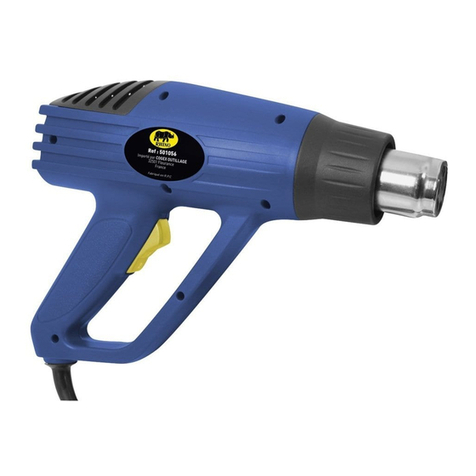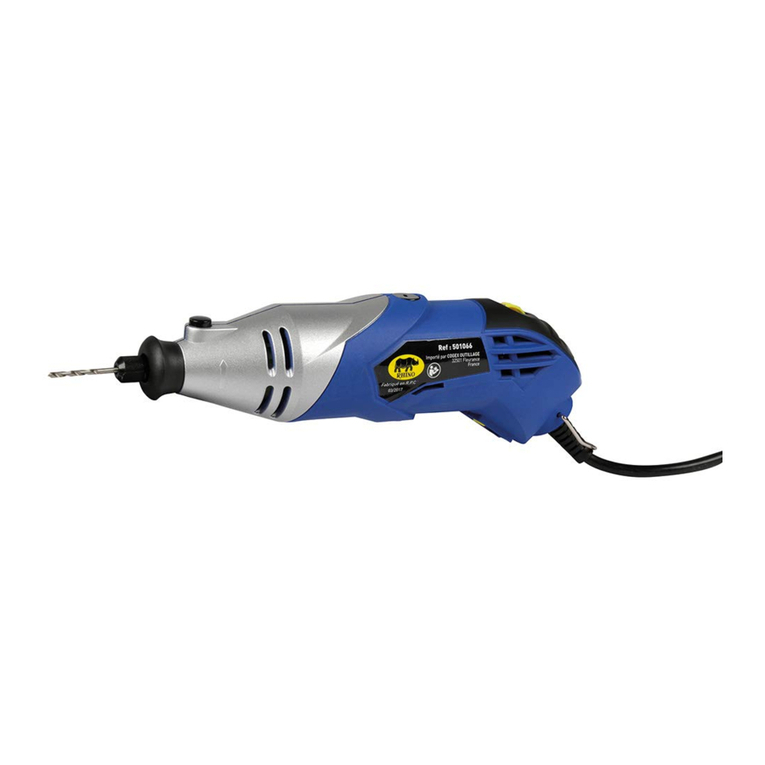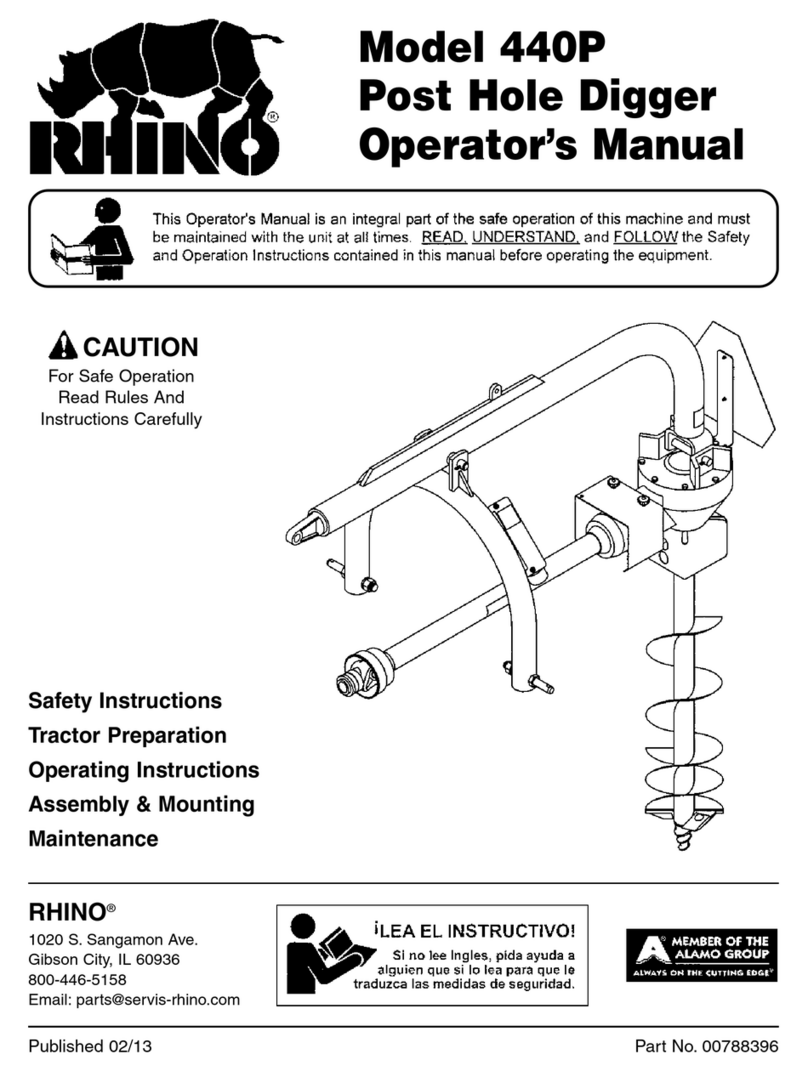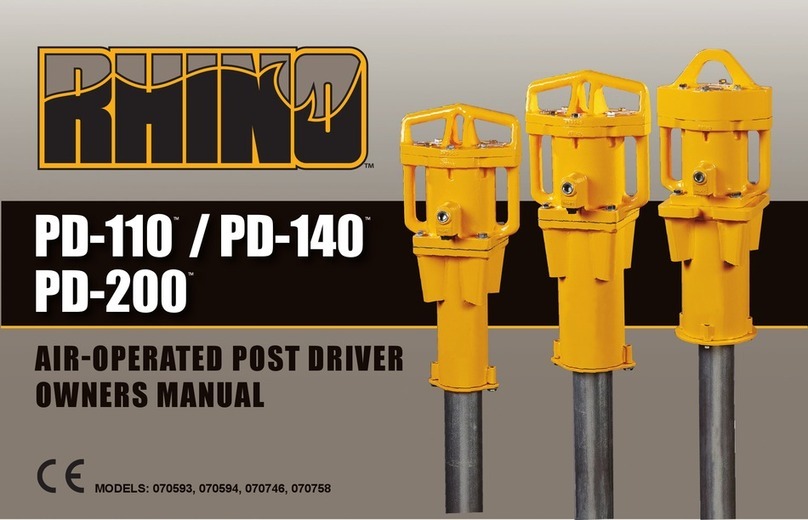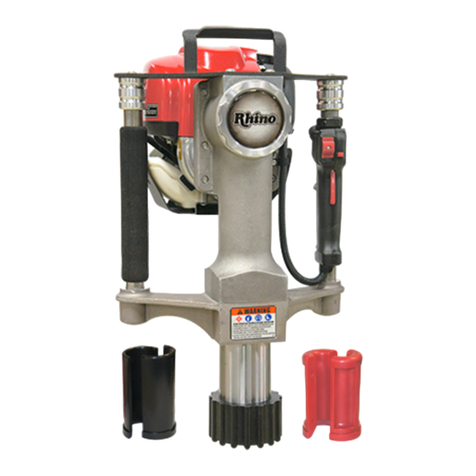
29
i
i
To help you make informed decisions about safety, you
will nd important safety information in a variety of forms,
including:
• Safety Labels on the post driver
• Safety Messages Preceded by a safety alert
symbol and one of three signal words, DANGER,
WARNING, or CAUTION. These signal words mean:
Immediate hazards that will result in
severe personal injury or death.
Hazards or unsafe practices that could
result in personal injury.
Hazards or unsafe practices that could
result in injury, product or property
damage.
• Safety Headings such as IMPORTANT SAFETY
INFORMATION.
• Safety Section such as POST DRIVER SAFETY.
• Instructions how to use this post driver correctly
and safely.
TROUBLE SHOOTING
Your safety, and the safety of oth-
ers, is very important. The proper
and safe use of your Rhino® post
driver is an important responsibility
and should be taken seriously.
Keep this owner’s manual avail-
able, so you can refer to it at
any time. This owner’s manual is
considered a permanent part of the
post driver and should remain with
the post driver if resold.
The information and specications
included in this publication were
in eect at the time of approval
for printing. Rhino Tool Company,
Inc. reserves the right, however,
to discontinue or change
specications or design at any time
without notice and without incurring
any obligation whatever. No part of
this publication may be reproduced
without written permission from:
Rhino Tool Company
Your safety, and the safety of oth-
ers, is very important. The proper
and safe use of your Rhino® post
driver is an important responsibility
and should be taken seriously.
Keep this owner’s manual avail-
able, so you can refer to it at
any time. This owner’s manual is
considered a permanent part of the
post driver and should remain with
the post driver if resold.
The information and specications
included in this publication were
in eect at the time of approval
for printing. Rhino Tool Company,
Inc. reserves the right, however,
to discontinue or change
specications or design at any time
without notice and without incurring
any obligation whatever. No part of
this publication may be reproduced
without written permission from:
Rhino Tool Company
!DANGER
!CAUTION
IMPORTANT
NOTE
This book contains important safety information.
Please read it carefully.
Call your local dealer, service center or Rhino Tool
Company for more assistance with your post driver
To help you make informed decisions about safety, you
will nd important safety information in a variety of forms,
including:
• Safety Labels on the post driver
• Safety Messages Preceded by a safety alert
symbol and one of three signal words, DANGER,
WARNING, or CAUTION. These signal words mean:
Immediate hazards that will result in
severe personal injury or death.
Hazards or unsafe practices that could
result in personal injury.
Hazards or unsafe practices that could
result in injury, product or property
damage.
• Safety Headings such as IMPORTANT SAFETY
INFORMATION.
• Safety Section such as POST DRIVER SAFETY.
• Instructions how to use this post driver correctly
and safely.
TROUBLE SHOOTING
!DANGER
!CAUTION
IMPORTANT
NOTE
This book contains important safety information.
Please read it carefully.
Call your local dealer, service center or Rhino Tool
Company for more assistance with your post driver
Symptom Explanation/Procedure
Post lodged in the
driver
In the event that a driven post ares and becomes lodged within the chuck, follow these steps:
1. Turn engine off. Remove the four 5/16” lower body bolts and separate the lower body casting from the driver body.
2. Slide the lower body casting down the post to expose the ared top of the post. With the proper cutting tool for the type
of post, cut through the post below the ared portion.
3. Once the ared portion is removed, slide the lower body casting off the post and reassemble it to the driver. Please
follow bolt tightening procedure and use threadlocker.
Recommendation: Do not use “thin-wall” or light gauge round post with the Fence Pro™. It is very likely to flare
this type of post at full throttle.
Drives post slow
or sluggish engine
performance:
Typically this is resulting from improper driver storage or over-lling the oil causing the oil to seep into the combustion
chamber. Position the driver vertically, remove the dipstick to check oil level. (See page 6) If you need to remove some oil,
dispose of it properly. If oil is at proper level, follow the procedure listed in “Pull-start is frozen or hard to pull.”
Pull-start is frozen
or hard to pull:
This typically results from oil seeping into the combustion chamber from improper driver storage or overlling the oil reservoir of the en-
gine. Remove spark plug and pull hand grip several times until it pulls freely. Replace the spark plug. Check the oil level in oil reservoir
to ensure proper level (page 6). Follow starting procedure. It is not unusual, for blue smoke to be emitted from the engine, let the engine
run until smoke clears.
Proper Storage: Do not lay horizontally on the driver side or resting on the engine. If the unit cannot be stored securely in the upright position, place the
chuck on a at surface, leaning toward the engine side until it is supported by the shroud and chuck. Position the driver on an angle with
the top handle at the topmost point.
Other problems
or technical
questions
Other problems or technical questions: Document your serial number and contact Rhino Tool Company. Phone: 309.853.5555 or
© 2013, 2015, 2017 Rhino Tool Company Inc., - All Rights Reserved
© 2013, 2015, 2017 Rhino Tool Company Inc., - All Rights Reserved
This owner’s manual is
considered a permanent
part of the post driver
and should remain with
the post driver if resold,
rented or loaned.
This owner’s manual is
considered a permanent
part of the post driver
and should remain with
the post driver if resold,
rented or loaned.
Symptom Explanation/Procedure
Post lodged in the
driver
In the event that a driven post ares and becomes lodged within the chuck, follow these steps:
1. Turn engine off. Remove the four 5/16” lower body bolts and separate the lower body casting from the driver body.
2. Slide the lower body casting down the post to expose the ared top of the post. With the proper cutting tool for the type
of post, cut through the post below the ared portion.
3. Once the ared portion is removed, slide the lower body casting off the post and reassemble it to the driver. Please
follow bolt tightening procedure and use threadlocker.
Drives post slow
or sluggish engine
performance:
Typically this is resulting from improper driver storage or over-lling the oil causing the oil to seep into the combustion
chamber. Position the driver vertically, remove the dipstick to check oil level. (See page 6) If you need to remove some oil,
dispose of it properly.
If oil is at proper level, follow the procedure listed in “Pull-start is frozen or hard to pull.”
Pull-start is frozen
or hard to pull:
This typically results from oil seeping into the combustion chamber from improper driver storage or overlling the oil reservoir of the en-
gine. Remove spark plug and pull hand grip several times until it pulls freely. Replace the spark plug. Check the oil level in oil reservoir
to ensure proper level (page 6). Follow starting procedure. It is not unusual, for blue smoke to be emitted from the engine, let the engine
run until smoke clears.
Proper Storage: Do not lay horizontally on the driver side or resting on the engine. If the unit cannot be stored securely in the upright position, place the
chuck on a at surface, leaning toward the engine side until it is supported by the shroud and chuck. Position the driver on an angle with
the top handle at the topmost point.
Other problems
or technical
questions
Other problems or technical questions: Document your serial number and contact Rhino Tool Company. Phone: 309.853.5555 or
TAKE SAFETY SERIOUSLY
TAKE SAFETY SERIOUSLY
ii
ii




